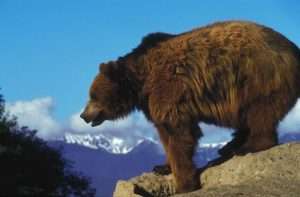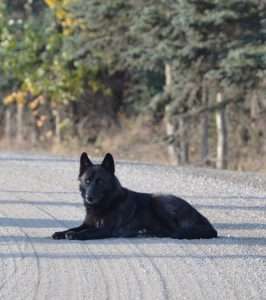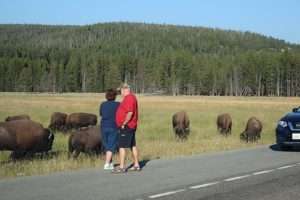 I recently read Richard Louv’s excellent book, Our Wild Calling: How Connecting With Animals Can Transform Our Lives–And Save Theirs. I was a bit worried it would dive too deeply into the sort of anthropomorphization that makes us lose what makes each species unique as we try to interpret them through our own biases, but I found Louv managed to walk that line between skepticism and wonder quite nicely. Near the end, he talked a bit about Harry Greene’s take on rewilding, particularly how to do it thoroughly you need to factor in the reintroduction of dangerous animals, which is often treated as a NIMBY sort of situation:
I recently read Richard Louv’s excellent book, Our Wild Calling: How Connecting With Animals Can Transform Our Lives–And Save Theirs. I was a bit worried it would dive too deeply into the sort of anthropomorphization that makes us lose what makes each species unique as we try to interpret them through our own biases, but I found Louv managed to walk that line between skepticism and wonder quite nicely. Near the end, he talked a bit about Harry Greene’s take on rewilding, particularly how to do it thoroughly you need to factor in the reintroduction of dangerous animals, which is often treated as a NIMBY sort of situation:
“Conservation shouldn’t be something other people do and pay for; it should be pursued everywhere in ways that share the costs and the dangers and the delights. ‘I’ve spent most of my career trying to get people to care about snakes, even rattlesnakes,” [Greene] said. “To a degree, I think I’ve succeeded.’ The key to this success is ‘telling the truth about snakes. It’s the same way with other dangerous animals: you have to tell the truth about them’ and then practice old and new methods of nurturing participation–and deeper connection and empathy with them. Answering this call will require empathetic understanding not only of other animals but of people as well.” (Louv, p. 250)
 This all stems from discussion about the reintroduction of “large animals who could kill us.” It’s one thing to think about the reintroduction of gray wolves (Canis lupus) to Yellowstone National Park, where they have plenty of room to avoid tourists and are often only seen for a few scant moments through spotting scopes. It’s another to consider the possibility of gray wolves that currently live in the north Cascades in Washington wandering their way west, across I-5, and into the Olympic Peninsula–perhaps even down into the Willapa Hills. Considering we had a verified sighting of a wolverine (Gulo gulo) on the Long Beach Peninsula a couple of years ago, it’s not entirely out of the question, though dispersing wolves have generally stayed in less populated areas.
This all stems from discussion about the reintroduction of “large animals who could kill us.” It’s one thing to think about the reintroduction of gray wolves (Canis lupus) to Yellowstone National Park, where they have plenty of room to avoid tourists and are often only seen for a few scant moments through spotting scopes. It’s another to consider the possibility of gray wolves that currently live in the north Cascades in Washington wandering their way west, across I-5, and into the Olympic Peninsula–perhaps even down into the Willapa Hills. Considering we had a verified sighting of a wolverine (Gulo gulo) on the Long Beach Peninsula a couple of years ago, it’s not entirely out of the question, though dispersing wolves have generally stayed in less populated areas.
Right now, the three biggest predatory animals here are black bears (Ursus americanus), cougars (Felis concolor), and coyotes (Canis latrans). Generally these animals are shy enough to run when confronted, and actual conflicts with humans are quite rare. But historic range maps also show gray wolves and brown bears (Ursus arctos) in the area. Wolf attacks on humans in recent times are exceptionally rare, and though brown bears are a much more serious threat than their smaller black bear cousins, most conflicts arise from an animal being startled or a mother defending cubs.
But the risk is not zero, and that makes a lot of people hesitant to embrace these animals in the same way they might welcome a reintroduced Oregon silverspot butterly (Speyeria zerene hippolyta) or California condor (Gymnogyps californianus). Folks in areas where these large predators are still common, like many areas in Alaska, tend to have a good understanding of how to coexist with them, and many people who move there do so because they want more wilderness in their lives. (Not that there aren’t those naïve enough to try to Disneyfy nature, or obstinate enough to want to wipe out the last holdouts of wild predators. But that’s another post for another time.)
I’ve been thinking a lot lately about how to facilitate better relations between western, civilized, often urbanized Homo sapiens, and the rest of nature. And I came to the conclusion that it starts with us setting aside our ego. Through culture, mythos, religion, economics, and more, we have written the story of the world in which we are at the top of the heap, and all other beings exist solely to serve us. It’s a very convenient tale, and of course we the writers place ourselves in the most favorable light, whether that’s innocent victim of evil wilderness creatures, or the brave savior vanquishing these dangerous animals and their harsh environs.
 But we know deep down that we aren’t always the victors. From the time our Australopithecine ancestors became bipedal, to modern day shock headlines blowing any injurious or fatal human-wildlife conflict into a Major Story (TM), we have plenty of examples of how we are sometimes the losers in that particular fight. While I feel safe going out for solo hikes in remote areas in the Pacific Northwest, I know that it is in part due to the fact that I am much less likely to run into large, dangerous animals than I would have been two centuries ago. Watching my step for rattlesnakes isn’t quite the same as keeping an eye out for a startled grizzly bear or a starving, desperate cougar trying their luck with me.
But we know deep down that we aren’t always the victors. From the time our Australopithecine ancestors became bipedal, to modern day shock headlines blowing any injurious or fatal human-wildlife conflict into a Major Story (TM), we have plenty of examples of how we are sometimes the losers in that particular fight. While I feel safe going out for solo hikes in remote areas in the Pacific Northwest, I know that it is in part due to the fact that I am much less likely to run into large, dangerous animals than I would have been two centuries ago. Watching my step for rattlesnakes isn’t quite the same as keeping an eye out for a startled grizzly bear or a starving, desperate cougar trying their luck with me.
And that, to me, is humbling. I don’t write myself as the brave conqueror of desolate wilderness as a way of justifying the massive ecological and cultural damage we’ve done to this and other lands. Instead, it’s a reminder that we basically had to wipe out any animal we saw as inconvenient in order to see the land as suitable for us to live on, and we weren’t brave or strong or smart enough to effectively live with them. Extermination is, to my mind, a coward’s way out, especially now when we have much more technology at our disposal to keep us safe from other beings without lethal actions.
Still, this brings us back to the fact that reintroducing large, dangerous animals to an area does raise the risk of people being injured or killed at least a tiny amount. And I’m not just talking about the predatory ones, but herbivores like moose (Alces alces) and American bison (Bison bison). The Facebook group Yellowstone National Park: Invasion of The Idiots™! is an ongoing record of incidents involving tourists getting much too close to the megafauna simply because they don’t seem to grok the dangers involved in approaching these seemingly “docile” animals. The most infamous may have been the 2020 incident where a woman got much too close to a herd of bison and received what may be the world’s most-viewed pantsing (spoiler–she was fine, luckily for her) but each tourist season brings a whole new slew of similar conflicts.
 This, of course, does not bode well for the possibility of rewilding even more remote lands with potentially dangerous animals. Of course there are going to be people getting injured or killed even in communities that are very well-versed at coexisting with local wildlife. But here in the U.S. nature illiteracy is so incredibly rampant that there’s going to have to be a lot of re-learning of things that should be common sense. Our perceived separation from the rest of nature has made us complacent and, quite honestly, ignorant.
This, of course, does not bode well for the possibility of rewilding even more remote lands with potentially dangerous animals. Of course there are going to be people getting injured or killed even in communities that are very well-versed at coexisting with local wildlife. But here in the U.S. nature illiteracy is so incredibly rampant that there’s going to have to be a lot of re-learning of things that should be common sense. Our perceived separation from the rest of nature has made us complacent and, quite honestly, ignorant.
I don’t think we should plan to just sacrifice a certain number of ill-prepared individuals in the process of rewilding. Instead, it’s going to take an incredible amount of education, both before and after the reintroduction of a potentially dangerous animal species. We’re already seeing some pretty good efforts around trying to educate people about how to live with critters that frequently live in close proximity to many people, especially those that a lot of people fear such as spiders or snakes. I’ve done my best to try to share information on topics like living with coyotes, or how to keep domestic dogs from starting or exacerbating conflicts with wildlife. And people who do live in the same areas as wolves and brown bears share information on the best ways to coexist with their wild neighbors.
Finally, I do want to point out that the route to coexistence is going to vary from place to place, depending on its suite of dangerous animals. Australia may not have grizzlies, but they have some of the most venomous snakes, spiders, and even octopi. And while those of us in urban areas in the U.S. may be pretty insulated from the most risky of wildlife, billions of people worldwide live side by side with animals that can–and occasionally do–kill them. So the discussion of whether to rewild or not has a great deal of privilege associated with it, and that conversation needs to be deeply entwined with the people who will be most affected in a given place, as well as people who have spent many years working on ways to help people adjust to coexisting with wildlife.
Though the pathway to rewilding isn’t going to be an easy one, it’s something we need to be discussing now more than ever. As wildlife populations are recovering (both with and without human assistance) and species begin to return to places where they were once extirpated, we cannot just let the kneejerk “kill them all” reaction be the only prevailing voice. We’ve already seen the ecological devastation that resulted from that brute-force tactic, and we need something more nuanced that protects us, but not at the expense of wholesale slaughter of entire species. We can–and must–do better than that.
